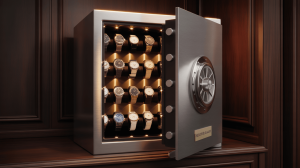Finding a single unit that locks away valuables and keeps automatic watches wound can be daunting. A dual-function home safe simplifies your life. It secures jewelry, documents, and watches behind steel walls. At the same time, it rotates automatic watches on precise turns-per-day (TPD) cycles. This guide explains how to select the ideal model. We cover security ratings, winder precision, interior layout, build quality, and budget considerations. By the end, you will know exactly what features matter most for your home safe with a built-in watch winder.
1. Determine Your Security Requirements
You must first identify what you need to protect. Some homeowners only store watches and jewelry. Others include cash, passports, or electronics. If you have high-value items, look for UL RSC or ETL burglary certifications. These standards ensure resistance against pry bars and drills. Fire protection is equally important. A UL 72 Class 350 fire rating guarantees internal temperatures remain below 350 °F for 30 minutes. Decide whether you need biometric access, electronic keypads, or traditional mechanical locks. Choose models that bolt to the floor or wall for added stability and to prevent removal.
2. Understand Watch Winding Specifications
Automatic watches need consistent motion. Without it, lubricants can congeal and timekeeping drifts. Built-in winding modules mimic wrist movements. You must check the turns-per-day (TPD) range. Entry-level winders offer 650–1,200 TPD. Premium units go up to 2,000 TPD. Direction control—clockwise, counterclockwise, or bi-directional—is crucial. Some watches require specific patterns to avoid wear. Also review pause intervals, which prevent over-winding. High-quality Japanese or Swiss motors keep noise under 25 dB. Rubber-dampened mounts reduce vibration. Ensure the winder settings match your watchmaker’s recommendations.
3. Evaluate Interior Layout and Capacity
A versatile interior ensures every item has its place. Look for padded drawers and removable trays. Velvet-lined inserts prevent scratches on metal and gemstones. Ring rolls, earring posts, and necklace hooks keep jewelry organized and untangled. Watch pillows should fit snugly into winding bays. Some safes include hidden lower drawers for documents, extra straps, or small electronics. Consider how many watches you own now and any future additions. A safe with modular trays allows you to expand capacity without buying a new unit.
| Interior Feature | Function | Benefit |
|---|---|---|
| Velvet-Lined Drawers | Cushions jewelry and small valuables | Prevents scratches and tangling |
| Removable Watch Trays | Hold and wind multiple watches | Scalable capacity |
| Hidden Lower Compartments | Store documents, straps, or electronics | Maximizes storage flexibility |
4. Check Build Quality and Materials
The safe’s construction determines its durability. High-end models use 12–14 gauge steel for the body and door. Weld seams should be continuous without visible gaps. Powder-coat finishes resist scratches and corrosion. Steel bolts and hinges must feel solid and smooth. Interior hardware should use corrosion-resistant metals. Some safes offer wood veneer or leather wraps for a decorative touch. Verify insulation materials for fire protection. Composite fireboard or ceramic insulation guarantees consistent performance in high heat.
5. Assess Climate and Humidity Controls
Leather straps, pearls, and metals suffer from humidity swings. Look for IP54-rated door seals, which block dust and moisture. Passive desiccant chambers absorb excess moisture over time. Premium safes include active dehumidifiers to maintain 40–50% relative humidity. Digital hygrometers display current levels. Some models allow you to adjust humidity settings via an app or built-in controls. A stable micro-environment preserves both watch movements and jewelry finishes without manual effort.
6. Review Smart Connectivity Options
Many modern safes offer Bluetooth or Wi-Fi modules. Real-time tamper alerts, door-open notifications, and low-battery warnings appear on your smartphone. A dedicated app may allow remote lock/unlock and winding schedule adjustments. Audit logs record every access attempt. Enterprise-grade encryption is vital to prevent hacking. If you travel frequently, smart connectivity ensures you can monitor and manage the safe from anywhere. Otherwise, a basic electronic keypad or biometric scanner may suffice.
| Connectivity Feature | Function | Advantage |
|---|---|---|
| Bluetooth Integration | Real-time alerts to smartphone | Immediate notification of tampering |
| Wi-Fi Module | Remote lock/unlock and controls | Manage settings from anywhere |
| Audit Log Tracking | Records every access event | Full accountability and traceability |
7. Compare Power Supply and Backup Solutions
Built-in winders and electronic locks require power. Most models include an AC adapter for daily use. Rechargeable lithium-ion batteries provide backup during outages. Check battery run time—some last a few days, others stretch to weeks. Low-battery LED indicators and app notifications are critical to avoid sudden shutdowns. Always ensure there’s a hidden mechanical override key or combination dial. This prevents lockouts if electronics fail. A dual-power system guarantees uninterrupted security and watch winding.
8. Measure Noise and Vibration Levels
A safe that hums or rattles can be disruptive in a bedroom or office. Premium watch winders use precision motors that run under 25 dB—about the volume of a whisper. Rubber-dampened motor mounts absorb vibration, preventing movement transfer to furniture. Soft-close hinges eliminate loud slams. Silent locking bolts reduce clicking sounds. Ask manufacturers for decibel measurements or read user reviews to gauge real-world performance.
9. Investigate Installation and Anchoring Methods
A safe is only as secure as its installation. Locate floor joists or wall studs before mounting. Use heavy-duty lag or sleeve anchors rated for the safe’s weight plus contents. Level the safe before fully tightening anchors to prevent door binding. Some models include pre-drilled anchor points; others require drilling on-site. Conceal anchor heads beneath the interior liner or cabinetry trim for a clean finish. Professional installation is recommended for larger or heavier units to ensure maximum stability and security.
| Installation Step | Action | Tip |
|---|---|---|
| Locate Studs/Joists | Use a stud finder to mark positions | Double-check markings before drilling |
| Select Anchors | Heavy-duty lag/sleeve anchors | Match anchor strength to loaded weight |
| Level Safe | Adjust leveling feet or shims | Prevent door binding and ensure smooth operation |
10. Examine Aesthetic and Design Integration
Your safe should fit seamlessly into your home décor. Choices range from matte-black powder-coat to walnut veneer or full-grain leather wraps. Flush-mount keypads and beveled glass panels add a luxury feel. Some safes feature LED lighting that activates on door opening. Consider how the safe’s color, finish, and size work with existing furniture. If you prefer a hidden appearance, look for models designed to recess into cabinetry or closets.
11. Factor in Maintenance and Longevity
Routine care keeps both your safe and valuables in top condition. Dust the exterior weekly with a microfiber cloth. Run empty winding cycles monthly to maintain motor health. Test locks and electronics quarterly. Replace desiccant packs every 6–12 months, depending on local humidity. Swap backup batteries annually. Lubricate mechanical locks per manufacturer instructions. A maintenance log helps track service dates and performance notes to avoid neglected issues.
12. Evaluate Budget and Value Proposition
Home safes with built-in winders span a wide price range. Entry-level models start around $1,500 for basic features and 2–4 winding bays. Mid-range units ($2,500–$5,000) add climate control, LED lighting, and smart alerts. Premium safes ($5,000+) offer custom veneers, biometric locks, and full IoT integration. Insurance companies often provide discounts for certified burglary and fire protection. Consider long-term savings from reduced watch servicing and fewer jewelry repairs when comparing upfront costs.
| Price Tier | Range | Core Features |
|---|---|---|
| Entry-Level | $1,500–$2,500 | 2–4 winding bays, basic jewelry drawers |
| Mid-Range | $2,500–$5,000 | Climate control, LED lighting, app |
| Premium | $5,000+ | Custom finishes, biometric lock |
13. Explore Alternatives and Separate Options
If cost or space is a concern, separate devices may work. A standalone watch winder costs $200–$500 for a 2-bay unit, while a dedicated jewelry safe runs $300–$800. Separate units occupy more space and lack unified security certification, which may reduce insurance benefits. They also require multiple keys or codes. A hybrid safe consolidates both functions into one cohesive package, saving space and offering streamlined management.
14. Read User Reviews and Brand Reputation
Before purchasing, research user feedback. Look for real-world insights on build quality, noise levels, and winding accuracy. Check brand reputation for customer support and warranty coverage. Established manufacturers often provide longer warranties and responsive service. Pay attention to issues like false alarm triggers or software glitches in smart models. User reviews can uncover potential drawbacks and highlight the best-performing units.
15. Making the Final Decision
When choosing your ideal safe, balance security, winding precision, interior organization, design, and budget. Score each model based on the criteria outlined above. Consider your collection size, home décor, and tech preferences. If you have a large watch portfolio and valuable jewelry, a premium hybrid safe may be worth the investment. Casual collectors might opt for a mid-range model. Ultimately, choose a safe that meets your present needs and offers room for future growth.
FAQ
Q1: How often should I run the watch winding modules?
Run winding cycles daily or every other day. This keeps lubricants evenly distributed and ensures accuracy.
Q2: Can I store both quartz and automatic watches in a hybrid safe?
Yes. Quartz watches sit in static trays, while automatics go in winding modules.
Q3: What maintenance does the safe require?
Dust exterior weekly. Run empty winding cycles monthly. Test locks and electronics quarterly. Replace desiccant packs every 6–12 months. Swap backup batteries annually.
Q4: Are smart connectivity features secure?
Premium models use AES encryption and require strong, unique passwords. Always update firmware to protect against vulnerabilities.
Q5: Do I need professional installation?
Recommended for larger or built-in units. Professional anchoring ensures stability, correct leveling, and maximum security.







